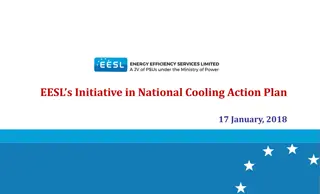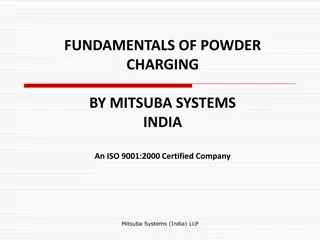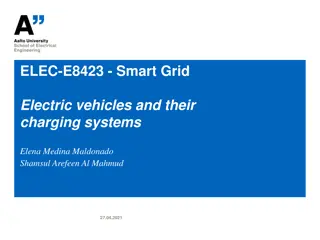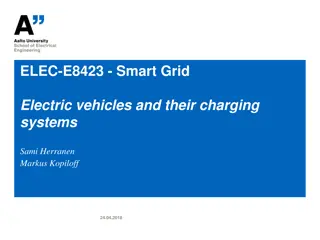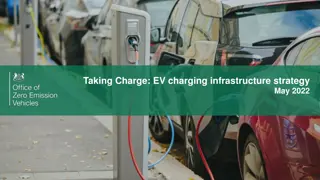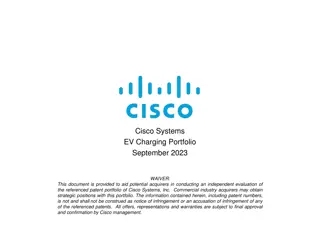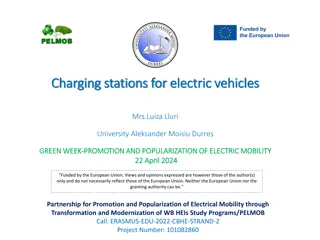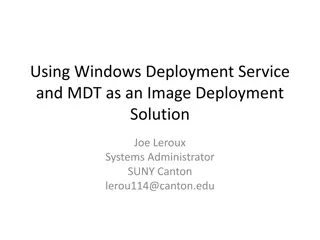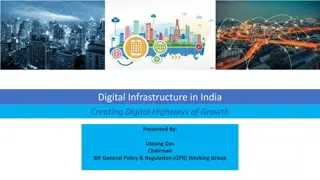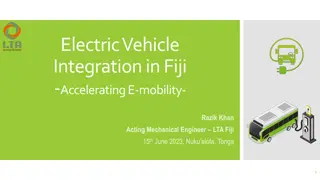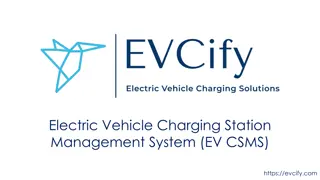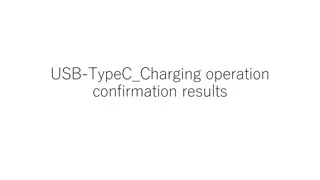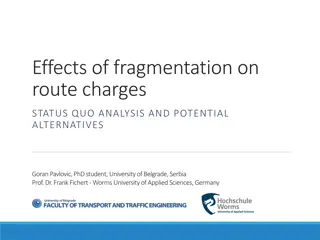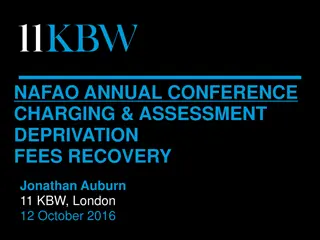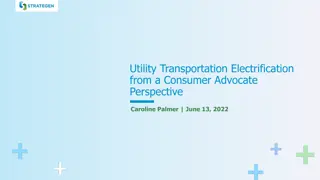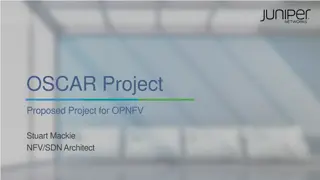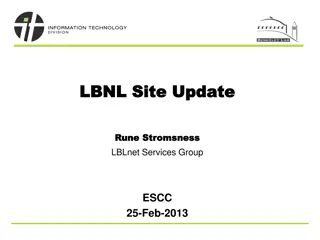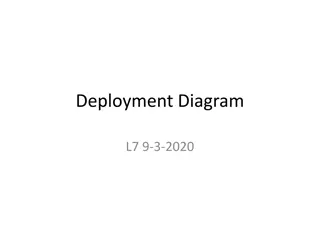Deployment of Charging Infrastructure by EESL in India
Government of India, through EESL, is driving the deployment of clean mobility solutions like EVs and EV chargers across the country. EESL's national e-mobility program focuses on promoting EV adoption, aggregating demand, and setting up public charging stations. With a strong emphasis on low-cost finance, demand aggregation, partnerships, and sustainable business practices, EESL is leading the way in the transition to electric vehicles in India.
Download Presentation

Please find below an Image/Link to download the presentation.
The content on the website is provided AS IS for your information and personal use only. It may not be sold, licensed, or shared on other websites without obtaining consent from the author. Download presentation by click this link. If you encounter any issues during the download, it is possible that the publisher has removed the file from their server.
E N D
Presentation Transcript
Deployment of Charging Infrastructure
Context and Rationale Government of India is working towards promoting deployment of clean mobility solutions including EVs EV policies for 12 States and EV tariff for 17 States published. The tariff notified by the SERCs for EV charging stations is composed of: Energy Efficiency Services Limited (EESL), working under the Ministry of Power has been anchoring the EV eco-system development in the country undertaking demand aggregation for procuring EVs. With this context, EESL is proactively undertaking roll-out of Public Charging Stations in the country. USAID SPARC program supported EESL in feasibility assessment, locational assessment for EV PCS installation in Delhi, Chennai and Jaipur; enabling EESL to scale up PCS deployment across 13+ cities. Further, it is supporting several state governments in the transition by bringing in innovative business models and implementation wherewithal for accelerated roll-out of public charging infrastructure. a) Fixed charges/demand changes: Varies between INR 0 - 160 per kW (or kVA) per month b) Energy charges: Varies between INR 4 - 7.7 per kWh 2
National e-mobility program of EESL EESL s national e-mobility programme was launched on March 7, 2018 Under this programme, EESL is actively playing a role in promoting the adoption of EVs and deployment of EV chargers across the country. EESL has aggregated demand of EVs and chargers from various government departments such as the Prime Minister s Office, Fifteenth Finance Commission, MoP, NITI Aayog, UN Environment, NDMC, SDMC, GMDA, NTPC, PGCIL, PFC, among others EESL has already deployed around 1,510+ EVs and 470+ captive chargers across Government offices in the country EESL is now focusing on setting up PCS across the country to support EV adoption amongst the general public. 3
EESL rollout plan for EVs and PCS Utilization Cost Efficiency Preparedness Experience Low cost finance: Low cost line of credit available to the tune of ~USD 450+ million Demand Aggregation and Bulk Procurement: 10,000 e-cars and 2,500+ chargers procured Partnership: Ministries, government departments, MoUs / In principal approval with 20+ land owners Location assessment: Completed across 11 cities and in-progress across 3 cities Operation and Monitoring: Working models of Mobile App & Monitoring Reports EV leasing: Leasing out EVs to Government Depts. as well as Pvt. entities through regional offices across all state capitals in the country. Shared infrastructure: Partnering with Fleet operators like BluSmart, EEE taxi and others to use EESL installed chargers. E-cars under deployment: 1500+ PCS installed: 470 captive chargers (170 DC001; and 300 AC001); and 70 PCS installed Relationship with stakeholders: Strong relationship with Municipal Corporations through regional offices; and with Utilities through programs such as smart meter rollout, UJALA, etc. Sustainable Business / Affordable lease and tariff 4
Installation of public chargers by EESL MoU signed / in principal approved BSNL Location assessment status Apart from these entities, EESL has also signed MoU/agreements with Kalinga University, Naya Raipur, BPCL, HPCL and Apollo Hospital for installation and use of public chargers SN City Name 1 Chandigarh In-progress 2 NDMC and SDMC Delhi 3 CIDCO, PWD, MSEDCL Mumbai 4 AMC Ahmedabad 5 GHMC, CDMA Hyderabad Investment envisaged - INR 250 crores for 1500 EV Chargers 6 NOIDA Noida 7 GMDA Gurugram 8 JMRC Jaipur 9 CMRL Chennai 10 NKDA Kolkata 11 BMRCL Bangalore 12 EDG Goa In-progress 13 Nagpur Metro Nagpur 14 CSC e-gov* CSC In-progress Total 5 *Chargers focused for 2W and 3W in tier 2 and 3 cities
Approach by EESL for deployment of EV Public Charging Station (PCS)
Approach for installation of Public Charging Stations 1 2 3 4 5 Sustainability of business operation Approach and Design Location Assessment Operation Implementation Categorizing city into a grid of 3km x 3km Secondary assessment of potential focus areas Stakeholder mapping and business model blueprint Agreement signing with the city municipality Application for power connection with DISCOM Procurement of charger Installation of charger Operation and maintenance of chargers Monitoring and Evaluation Customer service Cost recovery Tie ups with OEMs and fleet operators Other sources of revenue Innovative pricing and periodic review List of sites for assessment Formation of joint survey team Site visit and assessment on pre-defined parameters 7 EESL partnered with the USAID SPARC Program to develop and implement a scalable business model for PCS. USAID led Smart Power for Advancing Reliability and Connectivity (SPARC) program is a three-year bilateral program with the Ministry of Power.
Stakeholder mapping and business model blueprint EESL maps stakeholders & ties-up with site owners to install PCS EESL owns and operates PCS over their life-time (~10 years) Win-win value proposition for EV users Unique mechanism of land leasing from site owners Load sanction Application Service Agreement EESL Site Owner Demand aggregation by EESL enabling bulk procurement Procure, Install, Operate and maintain Land / Park space Power Utility Land rental Power tariff Low cost financing used by EESL Power connection EVSE Proposed rental @ INR per kWh of power consumption / fixed parking rental Charging service EV charging tariff Affordable PCS services for the end-consumers User Co-ordination Delivery Cash flow 8
Partnership with various stakeholders Agreements / MoUs signed with: Agreement / MoU signing with site owner SDMC NDMC CSC e-Gov NOIDA CMRL CDMA Apollo Hospitals JMRC Load sanction Application with the Power Utility BSNL, Punjab & CHD CIDCO GHMC Nagpur Metro 9
Procurement and Installation 2,500+ Chargers procured so far 70+* 170 DC001 chargers deployed Public charging stations for EVs installed (As of December 2019) 300 AC001 chargers deployed ~20% reduction in cost of charger by demand aggregation and bulk procurement India s first large-scale installation of public Chargers** * 66 chargers in Delhi-NCR, 2 in Nagpur and Chennai each 10
Dashboard for monitoring and mobile app for customer interface Monthly monitoring report Mobile Application Dashboard 11
EV charger utilization till date New Delhi Charger utilization till date is between 5-10% It is observed that chargers are utilized the most during the weekdays 10.5% 9.5% 9.2% 8.7% 8.6% 8.6% 8.5% 8.4% 7.1% 6.2% 5.5% 5.1% 4.8% 4.4% 4.2% May June July August September October November December Mon Tue Wed Thu Fri Sat Sun Range anxiety discovered has reduced to 33 km from 53 km in May Over the course of the day, maximum charging happens in Morning and Afternoon times 9.1% 87.7% 86.4% 8.7% 85.3% 82.3% 85.0% 79.9% 83.0% 79.4% 6.8% 6.4% 51.4% 51.1% 49.8% 47.4% 46.7% 42.4% 37.7% Range anxiety 33.90% Morning (0500- 1200) Afternoon (1200- 1700) Evening (1700- 2100) Night (2100-0500) 12 May June July August September October November December
Range of strategies adopted to create win-win partnerships Select Partners Strategies adopted for addressing the barriers Metro operators Chennai Metro Jaipur Metro Bangalore Metro DISCOMs NDMC JVVNL BSES Upfront costs - Demand Aggregation Utilization - Right location assessment - Partnership with cab aggregators (subscription deals) - Regular monitoring and actions (analytics) Cab aggregators Blu Smart Ola Meru Municipalities NDMC SDMC NOIDA JMC & JDA Operational cost - Offset through asset monetization (advertisement / non-tariff revenues) - OEM alliances - Policy & regulatory advocacy EESL Other land owners BPCL HPCL Apollo Hospitals CSC e-Gov Charger OEMs Delta Exicom BHEL Provision of Land - Partnerships based on revenue share with municipalities, discoms etc. (win-win) 20+public and private entities and expanding 13
Key learnings from chargers deployed Key learnings Description EESL s approach EESL undertakes detailed location assessment to study access to the site EESL proactively visits sites and reaches out to parking management vendors for reservation of parking space for EVs. Some parking locations have obstructions at the entry / exit. It is important to put a mandate for access clearance for EVs across all parking locations; and the space reserved for EVs at all locations should not be used by non-EV users. Access The process for load application and sanction is time taking as there are approvals required at several levels. EESL partners with DISCOMs for location assessment to facilitate faster approval and load sanction. Connection Some states do not have tariff category for EV charging stations, which puts EV charging under commercial category, making the end consumer tariff high and unaffordable. Power tariff EESL provides policy advocacy support (if required) Charger mix EESL has deployed chargers based on traffic flow, space and load available, basis detailed location assessment. Charger mix may differ from one location to another depending on conditions such as space and available load. EESL is partnering with OEMs and fleet operators to improve charger utilization. EESL is exploring non-fare revenue options through advertisement / marketing The utilization of charger is fairly low, while the cost of charging is inversely co-related to the utilization of chargers. Utilization 14
Thank You N. Mohan DGM (Head-EVCI) nmohan@eesl.co.in


